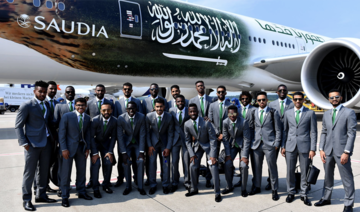ST. PETERSBURG: The priority for any visitor from the Middle East to St. Petersburg in early summer is inevitably … air conditioning.
The city that sprawls between the Baltic Sea and Lake Ladoga is renowned for its numbingly cold winters, but summertime can bring the opposite extreme. When I landed at Pulkovo Airport it was a humid 30 degrees, in brilliant sunshine, at 10 p.m. local time.
Seasoned Arabian Gulf residents are, of course, used to such extremes — the mix of sweltering heat outside, and AC-freeze inside. But I suspect — from the stifling humidity of the airport’s baggage collection hall, through to the blast of hot air that hit me as I later opened my hotel room door — that the Russians are more interested in winter heating than summer cooling.
True to form, the first identifiably Khaleeji person I met — an Emirati — had only one question for me: “Is there AC in the rooms,” he asked on the way up in the hotel lift. It turned out there was, but it was controlled centrally for each floor.
Maybe it was some throwback to the communal living of Soviet days, but a word with reception saw it notched down a couple of degrees for the night.
I chose my hotel — one of the Radisson chain — because it was close to the Expoforum site where the St. Petersburg International Economic Forum (SPIEF) is being held, as well as a mere 20-minute taxi ride from the airport. And a nice, cheery and friendly place too.
But the Park Inn in Pulkovskaya is not especially well located for the city center, which is where my first assignment of the following day took place. After a sticky night that never really seemed to get dark, I was on the road to the State Hermitage Museum bright and early.
It was a good opportunity to get a sense of this historic city, aided by Google Maps. St. Petersburg — or at least the part of it I saw that first day — is a substantial, affluent and well laid out conurbation, with broad avenues all heading to the center like the spokes of a wheel, and plenty of green spaces and public squares.
There are, however, reminders of its often painful past. A huge statue of former leader Lenin on the intersection of Moskovsky Avenue and Leninsky Prospekt is a surprise — I thought they got rid of most of those?
Another is the gigantic obelisk monument to the heroes of the harrowing siege of the city during World War II visible from my hotel window. History is clearly a living force here.
The further I got toward the center, passing substantial granite buildings, magnificent public edifices and historic places of worship, the more the question occurred to me: How on earth could the Nazis have hoped to raze this city to the ground, as was their aim, if the Soviets had not held out during the siege?
Though the name Hermitage suggests a little one-person cabin, the reality is anything but, and it is easy to get lost if your taxi driver drops you at the wrong entrance, as mine did. After a frazzling walk across the enormous Palace Square I eventually managed to hook up with the Russian hosts and Saudi guests who were holding a cultural opening ceremony in the magnificent complex of buildings.
The Russians were all scurrying around getting ready for the top-level VIPs expected at the event; the Saudis were complaining about the quality of the air conditioning in the centuries-old building. It was pretty muggy.
The AC facilities at the modern Expoforum center — another 30-minute trip back up Moskovsky past Lenin and the war monuments — were state of the art. But even so, I noticed visitors at the Saudi Aramco stand in the main congress hall take a sharp intake of breath as they entered a micro-climate that was several degrees colder than the rest of the sprawling forum center.
Perhaps somebody from the Kingdom got his AC wish at last, and had the thermostat turned down several degrees just in that spot.
- Frank Kane is an award-winning business journalist based in Dubai. Twitter: @frankkanedubai












